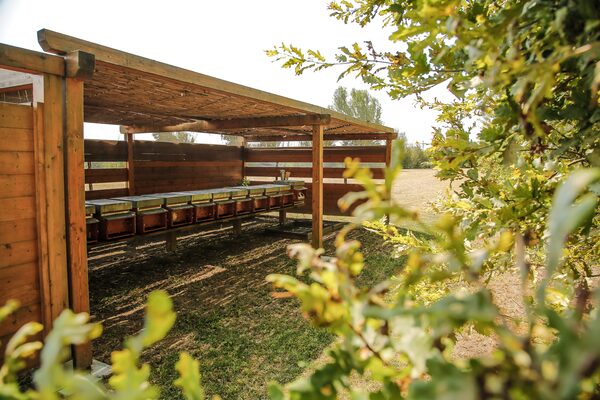
At Lamborghini's new energy-efficient paint facility, 95 per cent of the colours are water-based.Foto Umberto Guizzardi
Lamborghini, the Italian automaker known for its high-performance, gas-guzzling, exotic-looking supercars, probably doesn’t come to mind when you think of sustainability. But maybe it should. Its environmental initiatives date back more than a decade.
Lamborghini started sustainability projects in 2009 as a way of offsetting the carbon emissions produced at its plant. “Now, sustainability is a trend in the last year, but in 2009, it was not a trend. For us, it was a priority,” said Ranieri Niccoli, chief manufacturing officer at Automobili Lamborghini, during a winter-driving program I attended at its headquarters in Sant’Agata Bolognese. When Niccoli joined Lamborghini, the first eco-friendly item on the agenda was adding solar panels to the factory roof. At the time, it was the biggest solar-panel field in the region.
“Lamborghini is convinced that every person or company can contribute to the fight against climate change with more or less simple actions,” he added.

The 7,000-hectare Lamborghini Biopark is meant to promote biodiversity and study the relationship between forest density and greenhouse-gas emissions.Foto Umberto Guizzardi/Handout
It seems that Lamborghini’s efforts are noteworthy in the luxury automobile sector. In 2011, Lamborghini collaborated with the local Sant’Agata community and the universities of Bologna, Bolzano and Munich on a 7,000-hectare park dubbed the Lamborghini Biopark, near its headquarters. They planted 10,000 oak trees on the site in an effort to monitor air quality and pollution, promote biodiversity and better understand the relationship between forest density and the ability to absorb greenhouse-gas emissions.
“Sustainability plays a relevant role, as does profitability,” says Umberto Tossini, chief human capital officer at Automobili Lamborghini. “We’re connected with the neighbours of our plants, but we are even connected with our community that believes Lamborghini is a company for the future, even if we are producing products that are polluting with the emission of our engines.”

An apiary was added to the Biopark in 2016.Foto Umberto Guizzardi
In April, 2016, Lamborghini added 12 beehives to the park. Scientists monitor the bees and analyze the honey, pollen and wax to determine the presence of pollutants such as pesticides, heavy metals and dioxins. The research contributes to global studies on the decline and disappearance of bees. And every year, employees get locally grown Lamborghini-branded honey to share with their families.
“We have some responsibility. By testing the honey, we can understand if there is any kind of pollution which we are creating around the factory. On one side, we are giving our employees honey, but we are looking for pollution or problems. Bees are the first ones which are suffering from it. It’s a step-by-step activity to reduce as much as we can the impact on the community,” Niccoli says.
The hives are used in scientific research, while the honey is given to Lamborghini employees to take home.Foto Umberto Guizzardi
The bees forage over a three-kilometre area – enough to study the environmental impact of Lamborghini’s new high-tech factory, built in 2018 for the production of the Urus SUV. The factory doubled in size, expanding to 160,000 square metres from 80,000 metres, but the plant retained its carbon-neutral certification – a rating it has held since 2015.
It received a “CO2-neutral” certification from Det Norske Veritas Germanischer Lloyd (DNV GL), a third-party environmental risk-management and monitoring organization, for reducing the energy and water used in production and dramatically offsetting its carbon footprint. A new paint facility, for instance, uses considerably less energy than a similar facility. And 95 per cent of the paint colours are water-based, too.
“The paint shop is always dealing with chemicals. But in the new paint shop, we’re using water-based product, using new technology which uses 30-per-cent less water consumption, 40-per-cent less of ground consumption [energy], and producing less CO2. We try to reduce the impact of our production process and to increase the environmental sensibility as well,” adds Niccoli.
For a company rooted in driving and high-performance sports cars, it seems like an interesting move for Lamborghini to encourage sustainable mobility options. The company launched a carpooling service for its employees to help reduce auto-related pollution and ease traffic congestion. “Not using cars – it’s not easy for us because we are completely in the middle of nowhere. There is no public transportation, no train, but we’re trying to encourage car-sharing and carpooling. We’re also in discussions to create a bicycle path with the municipality,” Niccoli says. So far, 450 employees are carpooling, which has already reduced greenhouse-gas emissions by approximately 26 tonnes.
More recent evidence of the Lamborghini’s commitment to reducing its environmental footprint can be seen in new products coming down the pipeline. It’s working on hybrid technologies in collaboration with the Massachusetts Institute of Technology. First up is the Sian, a hybrid Lamborghini super sports car that Niccoli vows will deliver “unsurpassed performance” in the hybrid sphere.
“It’s our first step into our route to electrification.”
Shopping for a new car? Check out the new Globe Drive Build and Price Tool to see the latest discounts, rebates and rates on new cars, trucks and SUVs. Click here to get your price.
Stay on top of all our Drive stories. We have a Drive newsletter covering car reviews, innovative new cars and the ups and downs of everyday driving. Sign up for the weekly Drive newsletter, delivered to your inbox for free. Follow us on Instagram, @globedrive.
 Petrina Gentile
Petrina Gentile